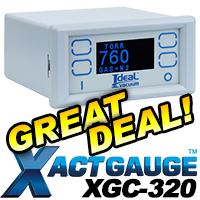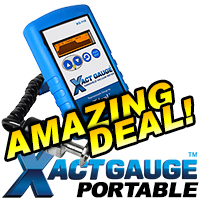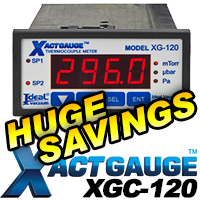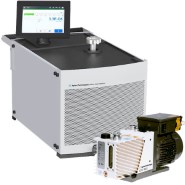The new Agilent HLD BR15 bench top Helium Leak Detector, with internal oil-sealed DS-302 rotary vane vacuum pump, combines the simplicity of operation with advanced system intelligence to give you easy access to powerful helium leak testing capabilities with hand held remote control (optional). This multi-function leak detector has single CPU architecture and depending on the model can leak check small parts to large vacuum chambers. The New HLD Leak Detector has a large color touch screen with two home screens and 180 degrees rotation. The setup is 4 times easier than competitive models and has the ability to save numerous "recipes" for quick recall. The unit setup has six pre-programmed key applications for both new and experienced users. They are: Sniffing, Spray Method, High Sensitivity, Auto Sequencer, PPM Testing and Split Flow. The minimum detectable leak rate available for this unit in vacuum mode is 5 x 10-12 mbar l/s. These Agilent HLD BR15 helium leak detectors operate on 100-120 or 200-230V, 50/60Hz, are designed to be placed on your laboratory workbench or casework, with external 10 CFM (14.2 m3/hr) oil-sealed DS-302 rotary vane vacuum pump, and have Agilent Part Number PN G8612A.
FEATURES of the Agilent HLD BR15 Helium Leak Detector Bench Top Model, PN G8612A:
- Contains a built-in turbo primary pump
- Large 10 CFM (14.2 m3/hr) oil-sealed DS-302 rotary vane roughing pump
- Enables fast pump down of medium sized vacuum systems
- 1.8 l/s helium pumping speed
- Large 8.4" (213 mm) high-clarity color display, TFT touch screen
- Minimum detectable leak rate 5 x 10-12 atm cc/s (5 x 10-12 mbar l/s)
- No cart supplied - For mounting on a laboratory workbench
- Large flat top work surface
- RS232 and analog interfaces are standard
- Selectable languages: Chinese, English, French, German, Japanese, Korean, Russian, Spanish
OPTIONAL ACCESSORIES for the Agilent HLD BR15 Helium Leak Detector:
- Helium Spray Gun Premium, PN: P1012177
- Helium Spray Gun with accessories, PN: P108765
- Standard Sniffer Probe, 10 ft, PN: P104104
- Standard Sniffer Probe, 20 ft, PN: P105928
- Agilent Varian Hand-Held Remote Control, wireless, PN: P105748
Easy to use The 8.4 in. color touch screen has excellent clarity, even at wide angles and intuitive menu structure for easy navigation. The HLD Series Leak Detectors combine the maximum simplicity with advanced expert system intelligence. Fully automated start-up and calibration maximize productivity.
Programmable test sequences improve testing efficiency.
Powerful (Broad Range of Test Methods)
The state-of-the-art spectrometer and vacuum system provide powerful capability, enabling a broad range of test methods for diverse applications.
High test-port pressure tolerance allows testing for large leaks.
High sensitivity (10
-12 Range) for finding the smallest leaks.
High pumping speed for helium insures fast response and clean-up times.
High-efficiency ion source and beam optics optimze sensitivity.
Versatile (Multiple System Configurations)
A wide range of options allows for broad configuration flexibility.
Primary pump and system mounting options to best suit your needs.
Multiple languages and units of measure for worldwide use.
Compact, lightweight design enables easy transport with wheels and storage compartment depending on model.
Dependable (Robust Design)
Robust design innovations allow the HLD Series Leak Detectors to conform to the most rigorous industrial standards and to operate dependably in the most challenging environments.
Fast clean-up times enhance overall system up-time.
Robust Faraday cup technology delivers high reliability and low cost of ownership.
Conforms to CE, UL, and CSA standards, assuring global acceptance.
This Leak detector comes in many configurations with rotary vane or dry scroll vacuum pumps (see list and technical specs below) Sold as Brand New and comes with Agilent Varian Manufacture Warranty. The Agilent HLD helium leak detector operating instruction manual and product brochure can be downloaded in PDF format below.
Helium Leak Testing Basics
Helium mass spectrometry, or helium leak testing, is a highly precise means of leak detection. This technology was first developed for the Manhattan Project during World War II to locate extremely small leaks in the gas diffusion process.
At the heart of helium leak testing is a complex piece of equipment called a helium mass spectrometer. Quite simply, this machine is used to analyze air samples (which are introduced into the machine via vacuum pumps) and provides a quantitative measurement of the amount of helium present in the sample. In practice, a "leak," is identified by a rise in the level of helium being analyzed by the machine.
Helium leak testing can identify extremely small leaks. For example, our equipment can detect a leak so small that it would emit just two cubic centimeters of helium (or the amount equal to two sugar cubes) in 320 years. While very few applications require this level of precision, this example serves to highlight the accuracy possible with this process.
While helium leak detection may appear to be a simple procedure, the process involves a combination of both art and science. The user must ensure the equipment is functioning properly and the process is highly dependent upon the user’s experience. Consider this analogy: while anyone with enough money can buy an airplane, learning how to fly one takes a lot of practice. The same is true with helium leak detection-make sure your "pilot" knows how to fly.
Why Is Helium Superior?
While many gases are used in leak detection, helium’s qualities provide for superior testing. Having an AMU (Atomic Mass Unit) of only 4, helium is the lightest inert gas. Only hydrogen, with an AMU of 2, is lighter than helium. However, due the hydrogen’s explosive potential it is rarely used.
Additional reasons why helium is a superior tracer gas:
- Only modestly present in the atmosphere (roughly 5 parts per million)
- Flows through cracks 2.7x faster than air
- Nontoxic
- Nondestructive
- Nonexplosive
- Inexpensive
- User Friendly
Due to these attributes, and its high sensitivity, helium leak testing has gained broad acceptance in a wide range of leak testing applications. Helium Leak Testings two primary testing modes while there are a variety of testing procedures, in general there are:
Two primary methods of helium leak testing:
- Spray Probe
- Sniffer Probe
The choice between these two modes is based on both the size of the system being tested, as well as, the level of sensitivity required.
Spray Probe: Provides Maximum Sensitivity
For this technique, the leak detector is hooked directly to the system under test and the inside of the system is evacuated. Once an acceptable vacuum is achieved, helium is sprayed discreetly on the outside of the system, with particular attention being paid to any suspect locations. Any leaks in the system, including defective welds (caused by cracks, pin holes, incomplete welds, porosity, etc.), flawed or missing gaskets, leaks due to loose clamps, or any other defect will allow helium to pass and be readily detected by the machine. The source of any leaks can then be accurately pinpointed and repaired.
The spray probe process is used to achieve the highest level of sensitivity. The equipment being used dictates the maximum sensitivity achievable; in Jurva Leak Testings case it is 2x10-10 std cc/sec. This technique does require that the system being tested is relatively leak tight prior to testing, as an ample vacuum is required for testing. However, by using special throttling devices a gross test can typically be performed. The gross test should eliminate any major leaks, permitting the use of increased sensitivity.
The following are examples of systems that we test using the spray probe technique:
- A-bar furnaces
- E-beam systems
- Laser systems
- Metal deposition equipment
- Distillation systems
- Vacuum systems
Sniffer Probe
For this technique, helium is purged throughout the inside of system being tested. Due to the innate properties of helium it readily migrates throughout the system and in its attempt to escape penetrates any imperfections, including: defective welds (caused by cracks, pin holes, incomplete welds, porosity, etc.), flawed or missing gaskets, leaks due to loose clamps, or any other defect. The system’s exterior is then scanned by using a probe attached to the leak tester. Any leaks will result in an increased level of helium nearest the source and be readily detected. Leak sources can then be pinpointed, providing the opportunity for immediate repair and retest.
Unlike the spray probe technique, this process is very flexible and can be adapted to meet the needs of any virtually any system in which helium can be injected. There is no practical size limitation. The sniffer probe technique is not as sensitive as the spray probe process, however, due to the amount of helium present in the air (approximately 5 ppm). The maximum sensitivity achievable under this procedure is approximately 1x10-6 std cc/sec. Nevertheless, this process is vastly superior to other traditional leak testing methods, such as: bubble testing, acoustic emission, liquid penetrant or vacuum box testing.
The following list is an example of systems that Jurva Leak Testing has tested using the sniffer probe process:
- Storage tanks (both above ground and below)
- Floating roofs
- Underground pipelines
- Underground cables
- Aseptic systems (flash coolers, heat exchangers, fillers, etc.)
- Any vessel/line or system that can be pressurized
Specialized Testing Techniques
In addition to the two primary testing procedures listed above, there are a number of more specialized techniques that can be utilized. Among these techniques, we routinely employ bagging or hooding and bombing. (content nicely written by Jurva Leak Testing, http://www.jurvaleaktesting.com/HeliumLeakTesting.html)











